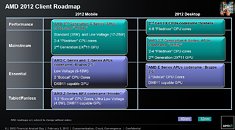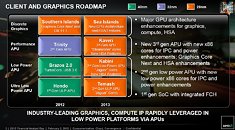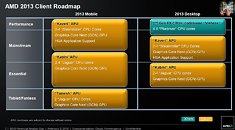- Joined
- Dec 6, 2011
- Messages
- 4,784 (0.98/day)
- Location
- Still on the East Side
Today at its annual Financial Analyst Day, AMD has presented an updated roadmap detailing the hardware it plans to bring to the table during 2012 and 2013. For this year, the Sunnyvale-based company is preparing a processor quarter which includes the Trinity, Brazos 2.0 and Hondo APUs (accelerated processing units) and the Vishera CPU.
Set to be the main weapon in AMD's x86 arsenal, the Trinity APU (aka the 2nd gen A Series) is made on 32 nm process technology, and features DirectX 11 graphics, two/four Piledriver cores (Piledrive is said to deliver 25% better performance than the Stars cores found in Llano APUs), and a TDP that can go as low as 17 W on mobile parts. Trinity is expected to debut in Q2 and already has close to 100 design wins (more than Llano had before its release).




The Brazos 2.0 (C and E Series) and Hondo (Z Series) APUs are 40 nm parts and feature up to two Bobcat cores, DirectX 11 graphics, and a TDP going from 4.5 W to 18 W. These are designed for low-power/low-cost mobile and desktop devices.
On the CPU front 2012 will see to the arrival of the 32 nm Vishera parts (2nd gen FX Series) which will feature 4, 6 or 8 Piledriver cores. Interestingly-enough, Vishera is listed as the sole CPU for 2013 desktops too so it seems AMD won't be doing much in this segment, apart from maybe releasing higher-clocked models.
For 2013 AMD is readying a LOT of 28 nm chips, including the Sea Islands GPUs - said to have a 'new architecture' and HSA (Heterogeneous Systems Architecture) features, and the Kaveri, Kabini and Temash APUs.
Kaveri is Trinity's successor and it will feature a DirectX 11.1-supporting (GCN-based) GPU, 2 to 4 Steamroller x86 cores, and HSA application support. Kaveri will cover the mainstream mobile and desktop segment so Kabini and Temash will focus on lower-cost/lower-power hardware.
Both Kabini and Tamesh will have GCN graphics and will make use of Jaguar x86 cores. Kabini will have up to four x86 cores while Tamesh will feature two. No ARM in sight here, maybe we'll have to wait a bit more...
View at TechPowerUp Main Site
Set to be the main weapon in AMD's x86 arsenal, the Trinity APU (aka the 2nd gen A Series) is made on 32 nm process technology, and features DirectX 11 graphics, two/four Piledriver cores (Piledrive is said to deliver 25% better performance than the Stars cores found in Llano APUs), and a TDP that can go as low as 17 W on mobile parts. Trinity is expected to debut in Q2 and already has close to 100 design wins (more than Llano had before its release).




The Brazos 2.0 (C and E Series) and Hondo (Z Series) APUs are 40 nm parts and feature up to two Bobcat cores, DirectX 11 graphics, and a TDP going from 4.5 W to 18 W. These are designed for low-power/low-cost mobile and desktop devices.
On the CPU front 2012 will see to the arrival of the 32 nm Vishera parts (2nd gen FX Series) which will feature 4, 6 or 8 Piledriver cores. Interestingly-enough, Vishera is listed as the sole CPU for 2013 desktops too so it seems AMD won't be doing much in this segment, apart from maybe releasing higher-clocked models.
For 2013 AMD is readying a LOT of 28 nm chips, including the Sea Islands GPUs - said to have a 'new architecture' and HSA (Heterogeneous Systems Architecture) features, and the Kaveri, Kabini and Temash APUs.
Kaveri is Trinity's successor and it will feature a DirectX 11.1-supporting (GCN-based) GPU, 2 to 4 Steamroller x86 cores, and HSA application support. Kaveri will cover the mainstream mobile and desktop segment so Kabini and Temash will focus on lower-cost/lower-power hardware.
Both Kabini and Tamesh will have GCN graphics and will make use of Jaguar x86 cores. Kabini will have up to four x86 cores while Tamesh will feature two. No ARM in sight here, maybe we'll have to wait a bit more...
View at TechPowerUp Main Site



 , dont know what it stands for but im thinking its the start of some advanced cpu gpu work shareing etc , anyone know more?
, dont know what it stands for but im thinking its the start of some advanced cpu gpu work shareing etc , anyone know more?



 they are getting their .
they are getting their .
